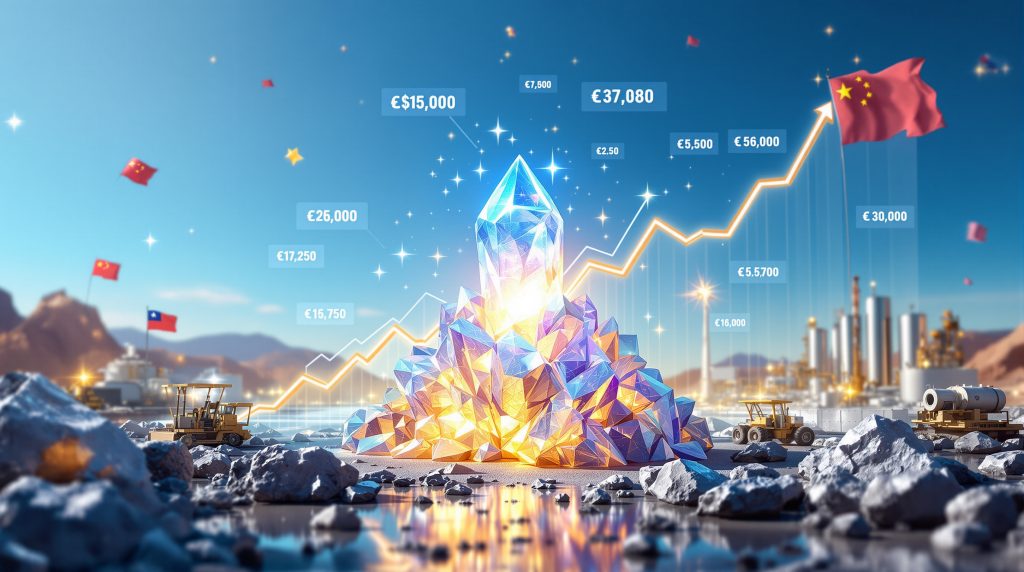The Lithium Market Turnaround: Understanding Recent Price Recovery
The lithium market has experienced a notable resurgence in 2025, with signs of recovery becoming increasingly apparent across the battery metals space. After enduring a prolonged downturn through 2023-2024, the sector is now witnessing a welcome lithium price rebound that has lifted spirits among industry stakeholders. This recovery marks a significant turning point for a market that has weathered considerable volatility in recent years.
Key Market Indicators of the Lithium Rebound
Industry observers have noted several positive indicators suggesting a strengthening lithium market. Battery manufacturers have become more active in restocking activities during the third quarter of 2025, signaling renewed confidence in future demand projections. This procurement activity has coincided with the price increases, creating a mutually reinforcing cycle of market improvement.
Market sentiment has undergone a noticeable shift from the previously bearish outlook to a more cautiously optimistic stance. Trading volumes have increased alongside rising prices, suggesting broader participation in the market recovery rather than isolated speculative movements.
Historical Context: From Peak to Trough and Back
The current lithium price recovery must be understood within its historical context. Following the extraordinary price surge of 2022, the market experienced a sharp correction as supply growth outpaced demand. This correction was particularly severe, with prices falling substantially from their peak levels as new production capacity came online and demand growth temporarily slowed.
Several key inflection points marked the market's journey through this cycle. The initial decline began in late 2022 as Chinese domestic prices started weakening. The downward momentum accelerated through 2023 as inventory levels built up throughout the supply chain. The market finally found its bottom in early 2024, with prices stabilizing at levels that rendered numerous operations uneconomical.
The recovery phase began gradually in mid-2024 before gaining more substantial momentum in 2025. This trajectory demonstrates the cyclical nature of commodity markets, where periods of underinvestment during downturns eventually lead to supply constraints and price recoveries.
What Factors Are Fueling the Lithium Price Recovery?
The current lithium price rebound stems from multiple factors converging simultaneously to create favorable market conditions. Understanding these dynamics provides insight into the sustainability of the recovery and its potential trajectory.
Supply-Side Restrictions Tightening the Market
On the supply side, several developments have contributed to market tightening. The closure of high-cost and uneconomic mining operations during the downturn removed significant production capacity from the market. Many marginal producers were unable to sustain operations as prices fell below production costs, leading to either temporary suspensions or permanent closures.
Major producers implemented strategic production cutbacks to balance supply with demand. These decisions represented rational responses to market conditions but collectively contributed to the current supply constraints. With demand now recovering, these voluntary production restrictions have accelerated the market rebalancing process.
Project timelines for new lithium developments have experienced delays due to various factors, including financing challenges during the downturn, permitting complications, and technical difficulties. These delays have extended the timeline for new supply coming online, further supporting the recovery in prices.
Strategic Industry Responses to Market Conditions
Industry participants have demonstrated strategic adaptations to the changing market environment. Major producers have implemented sophisticated inventory management strategies, carefully controlling the release of material to avoid flooding the recovering market. This coordinated approach has helped prevent price volatility despite increasing production levels.
Battery manufacturers have adjusted their purchasing behaviors, moving from the just-in-time inventory management that prevailed during the downturn toward more forward-looking procurement strategies. This shift reflects both current supply concerns and expectations of strengthening demand in the medium term.
Investment patterns within the lithium sector have noticeably pivoted toward optimizing existing operations rather than developing new greenfield projects. This prioritization of brownfield expansions enables producers to respond more rapidly to improving market conditions while managing capital expenditure more conservatively.
How Sustainable Is This Lithium Price Recovery?
The durability of the current lithium price recovery depends on both demand fundamentals and supply dynamics. Analyzing these factors provides insight into whether current trends represent a temporary bounce or a more sustainable market rebalancing.
Demand Fundamentals Supporting Higher Prices
Electric vehicle production targets from major automakers remain ambitious despite the challenges of recent years. Global automakers have reaffirmed their commitment to electrification strategies, with several announcing accelerated timelines for transitioning away from internal combustion engines. These commitments underpin long-term lithium demand projections.
Energy storage deployment is emerging as an increasingly significant driver of lithium demand. Grid-scale battery installations continue to grow exponentially in key markets, creating additional demand channels beyond the electric vehicle sector. This diversification of end-use applications strengthens the overall demand outlook.
Government policies worldwide continue to accelerate clean energy adoption through various mechanisms. Recent policy developments include enhanced purchase incentives for electric vehicles, stricter emissions regulations for conventional vehicles, and ambitious national targets for renewable energy integration. These policy frameworks provide structural support for lithium demand growth.
Supply Dynamics That Could Limit Price Growth
Despite the current favorable conditions, several supply-side factors could potentially moderate price increases in the medium term. New production capacity scheduled to come online in 2026 represents a significant expansion of global lithium supply. Several major projects are approaching completion after development delays during the downturn.
Technological innovations continue to reduce lithium intensity in battery formulations. Advanced battery chemistries and more efficient manufacturing processes are allowing manufacturers to produce batteries with lower lithium content per kilowatt-hour of capacity. This ongoing optimization could potentially moderate demand growth rates.
Recycling initiatives are steadily increasing the availability of secondary supply. As the first generation of electric vehicle batteries reaches end-of-life, recycling operations are scaling up to recover critical materials. While still representing a small percentage of total supply, recycling will become increasingly significant in the medium to long term.
What Are Expert Price Forecasts for 2025-2026?
Industry analysts and market experts have provided varied outlooks for lithium prices through 2025-2026, reflecting both the recovery momentum and remaining uncertainties.
Analyst Consensus and Price Projections
Current price forecasts reflect cautious optimism about market conditions. Regional price differentials remain significant, with Chinese domestic prices typically trading at different levels than European or North American markets. These regional variations reflect both logistical constraints and varying demand patterns.
Market observers note that price forecasts remain subject to considerable uncertainty. The speed of electric vehicle adoption, particularly in major markets like China, Europe, and North America, will play a crucial role in determining demand growth rates. Supply-side responses to improving market conditions, including the potential restart of previously mothballed operations, could also influence price trajectories.
Factors That Could Disrupt Price Forecasts
Geopolitical tensions continue to present risks to global supply chains. Resource nationalism, trade restrictions, and regional conflicts could all potentially disrupt the flow of lithium raw materials and refined products. These geopolitical factors introduce an element of unpredictability into market forecasts.
Technological breakthroughs in battery chemistry represent another potential disruption factor. Research into sodium-ion batteries, solid-state technologies, and other alternative energy storage solutions continues to advance. While commercial-scale deployment of these alternatives remains limited, technological developments could alter long-term demand patterns.
Regulatory changes in major producing countries could impact supply availability and development timelines. Environmental regulations, water usage restrictions, and community engagement requirements continue to evolve in key lithium-producing regions. These regulatory frameworks can significantly influence project economics and development schedules.
How Are Australian Lithium Miners Responding?
Australia's lithium industry position as a major producer makes the responses of its mining companies particularly significant for global market dynamics.
Operational Strategies Among Major Producers
Australian lithium operations have implemented various adjustments in response to market conditions. During the downturn, several operations implemented temporary suspensions or reduced production rates to weather the challenging price environment. As market conditions improve, these producers are carefully managing the resumption of full capacity.
Cost-cutting initiatives implemented during the downturn have positioned many Australian producers favorably for the recovery phase. Operational efficiencies, workforce optimizations, and supply chain improvements have collectively reduced production costs across the sector. These efficiency gains are enhancing margins as prices recover.
Exploration and development priorities have shifted in response to market lessons. Many Australian producers are focusing more selectively on high-grade, low-cost resource development rather than pursuing volume growth at any cost. This approach reflects a more disciplined capital allocation strategy based on experiences during the recent market cycle.
Financial Performance and Investment Outlook
Improving cash flow generation is allowing Australian lithium producers to strengthen their balance sheets after the challenges of the downturn. Debt reduction has been prioritized by several companies, enhancing financial flexibility for future growth opportunities.
Capital expenditure plans are being cautiously expanded as market conditions improve. Most producers are adopting staged approaches to capacity expansions, allowing for adjustments based on evolving market conditions. This measured approach reflects continued awareness of potential market volatility despite the improving outlook.
Dividend policies are being reviewed in light of strengthening financial performance. Several Australian producers have indicated intentions to increase shareholder returns as cash flow improves, balancing growth investments with income generation for investors.
What Does This Mean for Battery Supply Chains?
The lithium price rebound has significant implications throughout the battery supply chain, affecting everything from cathode material production to final battery assembly.
Downstream Effects on Battery Production
Cathode material pricing has begun to reflect the upstream lithium price movements, though typically with some lag time. Manufacturers throughout the supply chain are adjusting to the changing cost environment, with various degrees of ability to pass costs along to customers.
Manufacturing capacity utilization rates are improving as demand strengthens. Many facilities that operated below optimal capacity during the downturn are now increasing production rates. This improving utilization enhances operational efficiency and financial performance throughout the supply chain.
Supply agreement renegotiations are occurring throughout the industry as market conditions evolve. Long-term agreements established during the downturn are being revisited to reflect changing market realities. These negotiations balance price considerations with security of supply concerns.
Strategic Stockpiling and Inventory Management
Corporate inventory strategies are shifting in response to supply concerns and price expectations. Many battery manufacturers and automotive OEMs are moving from lean inventory models toward building strategic stockpiles of critical materials. This shift represents a significant change in procurement philosophy from the just-in-time approach that prevailed during the downturn.
Risk management practices are evolving to address supply chain vulnerabilities exposed during recent years. Diversification of supply sources, vertical integration initiatives, and enhanced inventory monitoring are all being implemented to improve resilience against future disruptions.
How Are Different Lithium Products Performing?
The lithium market encompasses several distinct products with unique supply-demand characteristics and price trends.
Comparison of Lithium Product Price Trends
Lithium carbonate and lithium hydroxide markets have shown somewhat divergent trends during the recovery phase. Historically, lithium hydroxide has commanded a premium due to its application in high-nickel cathode formulations. This pricing relationship has evolved during the current recovery phase, reflecting changing battery chemistry preferences.
Spodumene concentrate, the primary lithium mineral exported from Australia, has experienced its own recovery dynamics. As the upstream raw material for converted lithium chemicals, spodumene prices typically move in correlation with chemical prices but with distinct supply-demand balances affecting market timing.
Value-added lithium chemicals beyond the basic carbonate and hydroxide forms represent growing market segments. Specialized lithium compounds for specific battery applications or industrial uses have their own market dynamics, often with more stable pricing due to more specialized applications.
Quality Premium Developments
Battery-grade versus technical-grade price spreads have evolved during the recovery phase. The premium for battery-grade materials typically expands during tight market conditions, reflecting the more stringent specifications required for battery applications and the limited supply of qualifying material.
Purity requirements continue to drive premium pricing for the highest-quality materials. As battery manufacturers optimize performance and safety, specifications for lithium inputs have become increasingly demanding. This trend has created a more segmented market with significant price differentials based on quality parameters.
Regional quality certification standards are becoming increasingly important in price negotiations. Different markets may have varying specifications and certification requirements, creating price differentials between regions. These regional variations add complexity to global pricing benchmarks.
What Should Investors Watch for Next?
Investors monitoring the lithium sector should focus on several key indicators to gauge the market's direction and identify potential opportunities.
Key Market Signals to Monitor
Chinese domestic lithium pricing trends remain critically important as leading indicators for global markets. China's position as both the largest consumer and processor of lithium makes its domestic pricing particularly significant for understanding global trends.
Major producer quarterly production reports provide valuable insights into supply responses to improving market conditions. Production volumes, cost metrics, and expansion plans disclosed in these reports help gauge the supply side of the market equation.
Battery manufacturer procurement activities offer visibility into demand trends. Announcements of long-term supply agreements, stockpiling initiatives, or changing procurement strategies can signal expectations about future market conditions.
Electric vehicle sales data from key markets provides the most direct indication of end-market demand strength. Monthly or quarterly sales figures from China, Europe, and North America help quantify the pace of electrification and its implications for lithium demand.
Potential Market Disruptions
Emerging lithium extraction technologies could potentially alter supply economics. Direct lithium extraction methods, geothermal brine projects, and clay resource developments all represent potential disruptions to traditional supply sources. The commercialization timelines and cost structures of these alternatives warrant close monitoring.
Alternative battery chemistry developments continue to progress, potentially affecting long-term lithium demand projections. While lithium-ion technology remains dominant, ongoing research into sodium-ion, solid-state, and other alternative technologies could eventually impact market dynamics.
Mergers and acquisitions activity appears to be accelerating as market conditions improve. Consolidation within the sector could affect competitive dynamics, project development timelines, and market structure. Strategic partnerships between miners, processors, and end-users are also reshaping industry relationships.
FAQs About the Lithium Price Rebound
What caused lithium prices to fall from their 2022 peak?
The lithium market experienced a perfect storm of factors leading to the price decline from 2022 peaks. Rapid capacity expansion during the boom period created oversupply conditions as numerous projects accelerated development simultaneously. This supply growth coincided with slower-than-expected electric vehicle demand growth in key markets, creating a significant supply-demand imbalance.
Economic headwinds, including inflation, rising interest rates, and reduced consumer purchasing power, affected electric vehicle adoption rates. Many consumers delayed vehicle purchases or opted for more affordable conventional vehicles, temporarily slowing the electrification transition.
Inventory destocking throughout the supply chain amplified price pressures. As prices began falling, buyers delayed purchases in anticipation of further declines, creating a self-reinforcing downward cycle that persisted until inventories reached minimum operational levels.
How do lithium price changes affect electric vehicle costs?
Battery pack costs demonstrate meaningful sensitivity to lithium pricing, though the relationship is not directly proportional. Lithium typically represents approximately 8-12% of total battery pack costs, depending on chemistry type, pack design, and current price levels. This means that lithium price movements have a noticeable but moderated impact on overall battery costs.
OEM pricing strategies during lithium volatility vary considerably. During the downturn, cost savings from lower lithium prices were often retained to improve margins rather than passed through to consumers. Similarly, the current price recovery may not immediately translate to higher vehicle prices as manufacturers balance competitiveness with profitability.
Long-term supply agreements with price collars or averaging mechanisms help moderate the impact of spot price volatility on actual procurement costs. Most major automotive manufacturers and battery producers have established strategic supply agreements that smooth price fluctuations over time.
Will the lithium price recovery continue through 2026?
Supply-demand balance projections suggest a moderated but continued recovery through 2026, assuming electric vehicle adoption continues along expected growth trajectories. The market appears to be moving toward a more balanced condition after the extreme oversupply situation of recent years.
Production capacity coming online has a relatively well-defined timeline based on projects already in development. This supply growth will likely prevent a return to the extreme price levels seen in 2022 but may not fully offset demand growth if electric vehicle sales accelerate.
Energy storage sector expansion represents an increasingly significant demand driver that could support continued price strength. Grid-scale battery deployments and residential energy storage systems are growing rapidly, creating additional lithium demand beyond the electric vehicle sector.
How are junior lithium companies affected by the price rebound?
The project financing environment has improved considerably with the price recovery, benefiting junior lithium companies seeking to advance development projects. Equity markets have demonstrated renewed interest in the sector, while debt financing terms have become more favorable as price projections improve.
Valuation impacts for exploration companies have been particularly pronounced. Early-stage lithium companies experienced severe devaluations during the downturn, with many trading below cash value. The recovery has brought significant valuation improvements, though typically not yet returning to peak levels.
Development timeline adjustments reflect both improved financing conditions and lessons from the previous cycle. Many juniors are adopting more measured approaches to project advancement, with phased development plans and conservative production ramp-up schedules to manage capital requirements and market timing.
Navigating the Evolving Lithium Landscape
Balanced Market Outlook
The lithium market appears to be entering a period of more sustainable growth after the extreme volatility of recent years. The current recovery is characterized by more balanced fundamentals rather than speculative exuberance, suggesting a healthier market structure going forward.
Volatility will likely remain a feature of the lithium market despite the improving trend. As a relatively small commodity market experiencing rapid growth, lithium prices remain susceptible to short-term supply disruptions, demand fluctuations, and sentiment shifts.
Supply-demand balance is gradually normalizing after the severe imbalance of recent years. The combination of production curtailments, project delays, and recovering demand has accelerated the market rebalancing process. This improving balance should support continued price recovery while preventing extreme spikes.
Long-term Industry Transformation
The lithium industry is undergoing structural changes that extend beyond cyclical price movements. Integration of sustainability considerations throughout the supply chain is becoming increasingly important, with growing emphasis on environmental footprints, water usage, and community relations.
The market is evolving toward more mature commodity dynamics, including greater price transparency, more sophisticated financial instruments, and more diverse market participants. These developments should eventually reduce volatility and improve market efficiency.
Argentina lithium brines and the Thacker Pass lithium mine are contributing to a more geographically diverse supply landscape, while India's lithium supply strategy represents growing demand from emerging markets. Despite these global developments, Australia's position in the global lithium landscape remains strong despite the challenges of recent years. The country's resource endowment, established production capacity, and proximity to Asian processing facilities ensure its continued significance in global supply chains.
Ready to Stay Ahead of the Next Lithium Market Shift?
Don't miss crucial investment opportunities in the evolving lithium landscape. Stay informed with real-time alerts on significant ASX mineral discoveries through Discovery Alert's proprietary Discovery IQ model, empowering you to make strategic investment decisions before the broader market. Visit https://discoveryalert.com.au/discoveries/ to see how major mineral discoveries can generate substantial returns.




